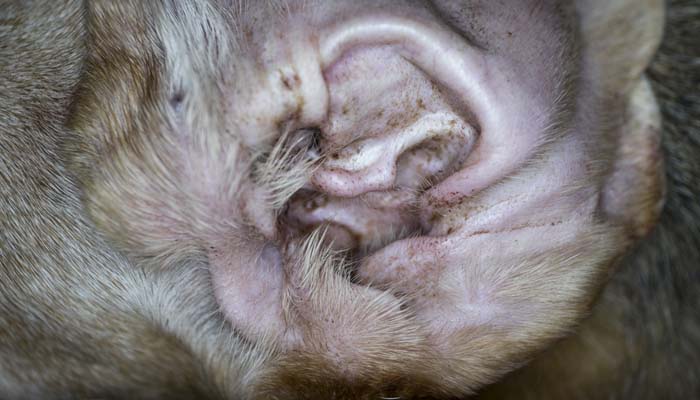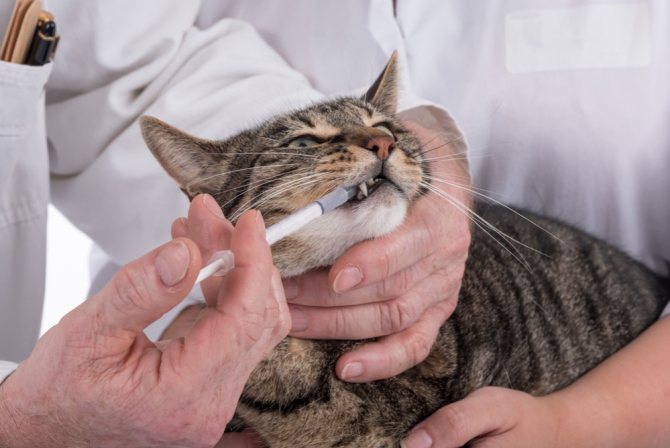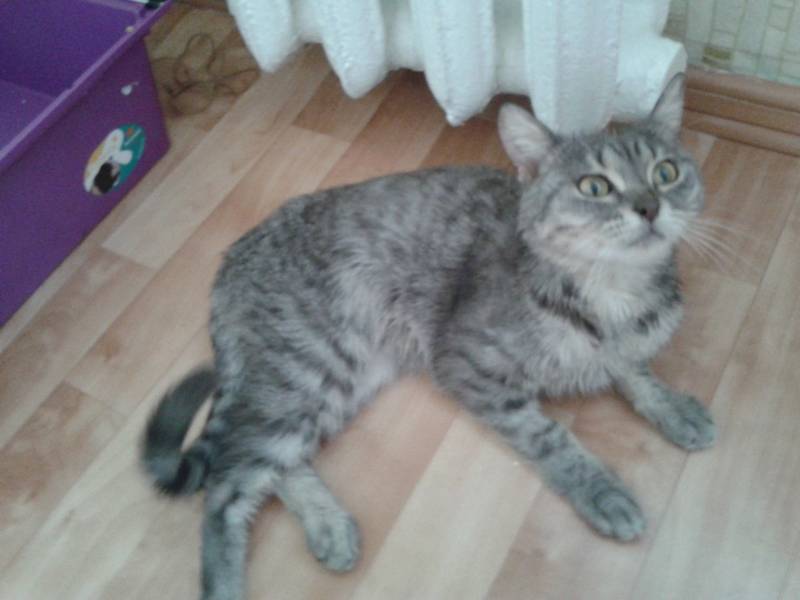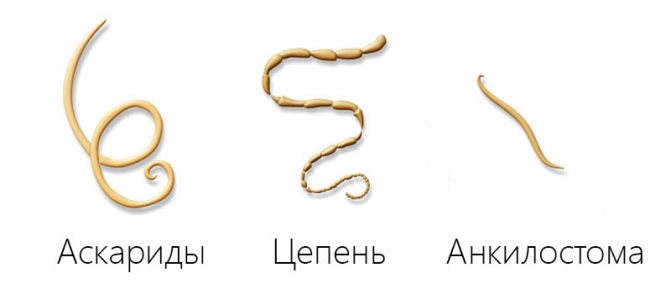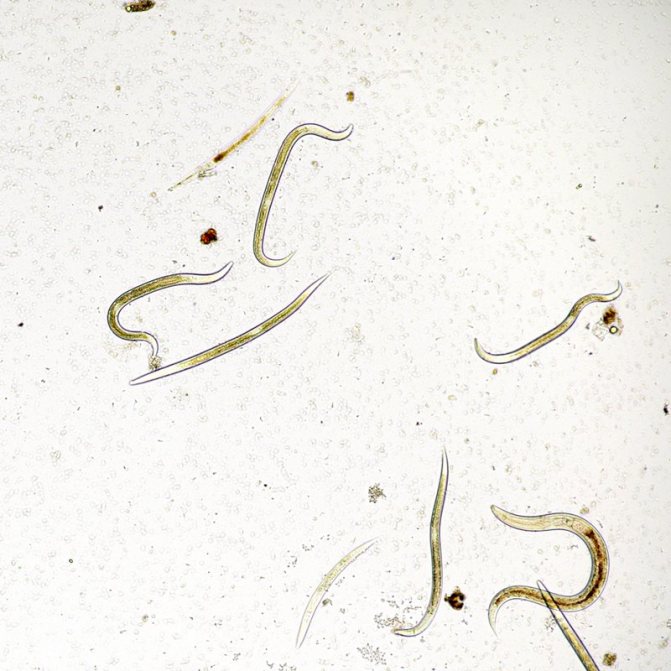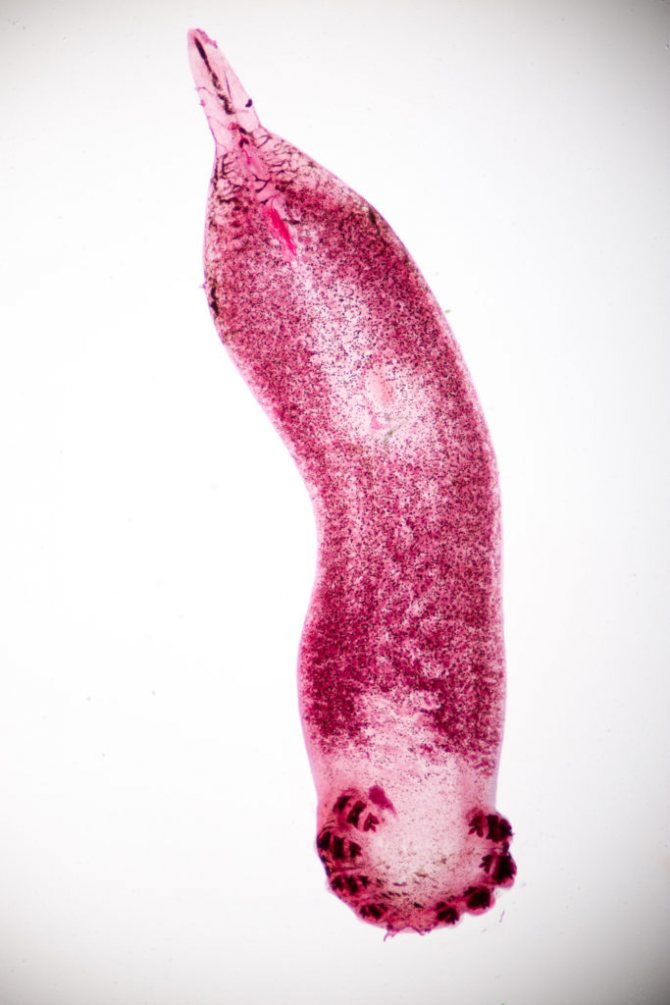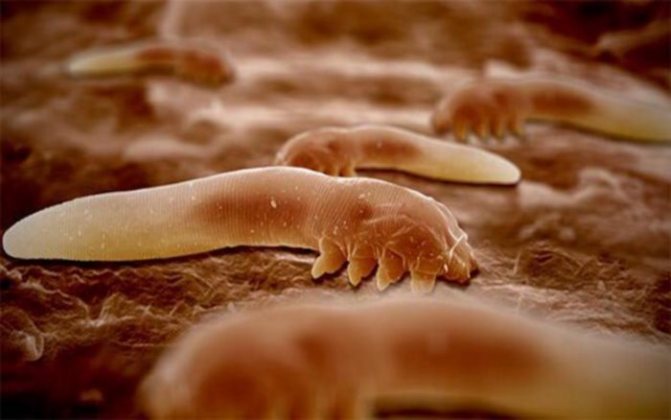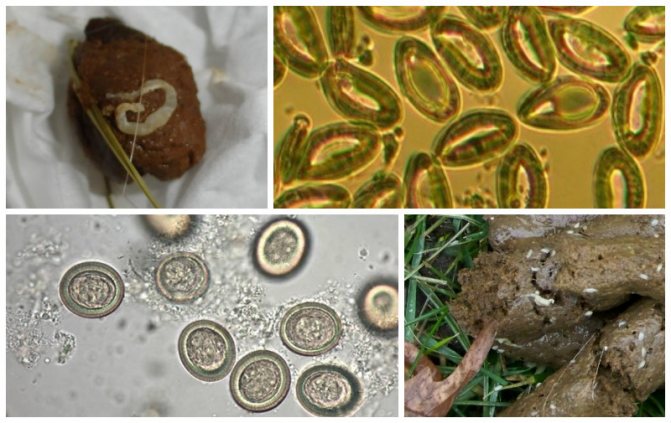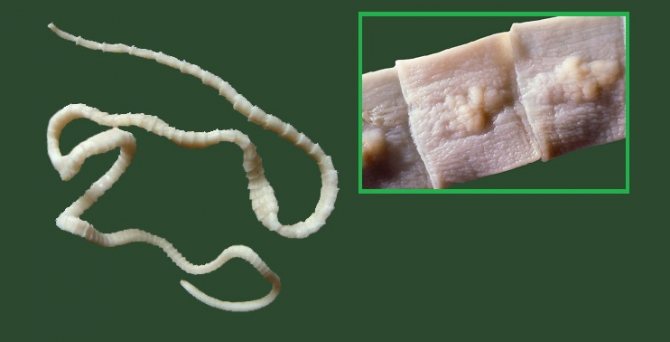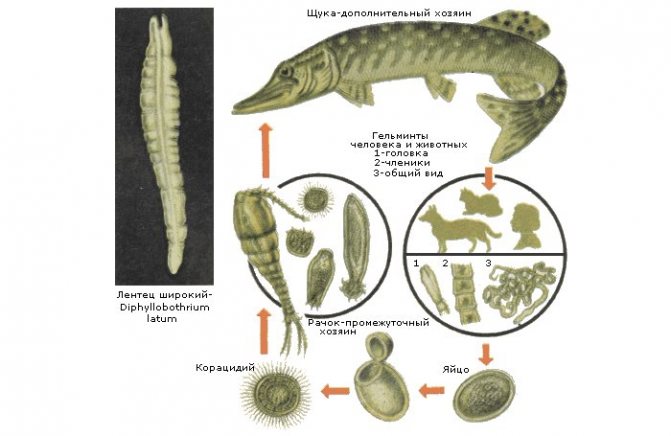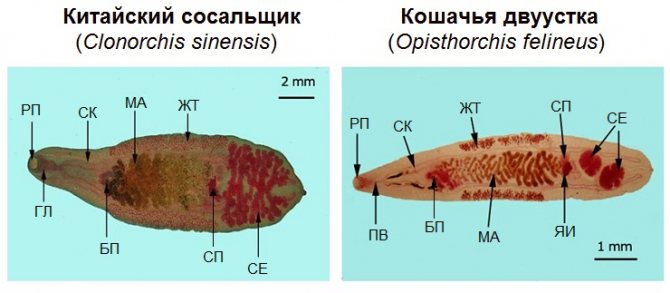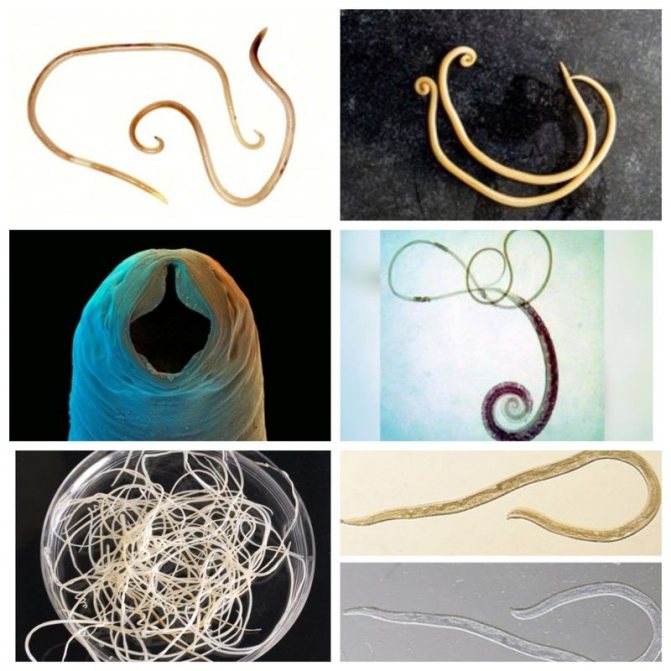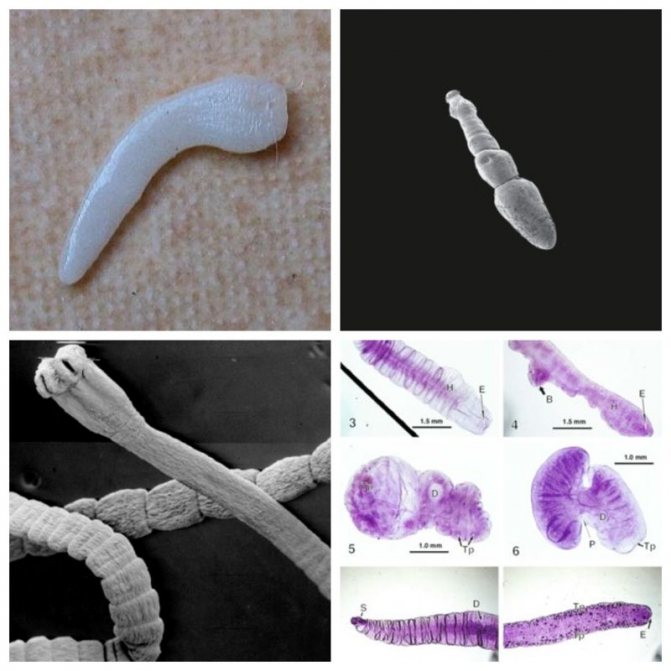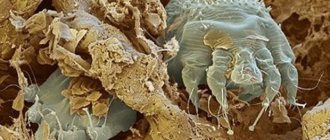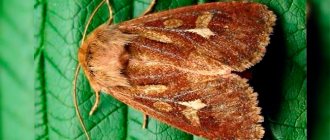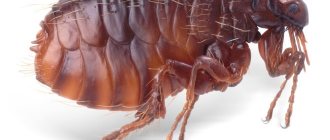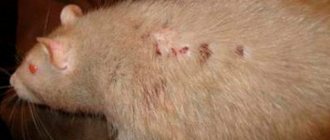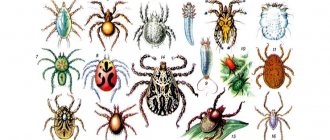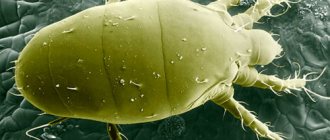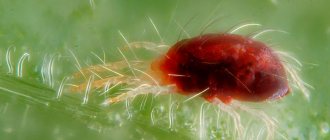Worms are common in cats. They are infected not only by animals that go outside, but also by those who lead a domestic lifestyle. Infection occurs when a cat comes into contact with the owner's shoes or with other objects brought from the street and inseminated eggs of worms. Pet infection leads to dysfunction in the body, but it is worth remembering that these same parasites can also infect the owner.
In this article, we will look at the main types of worms in cats, which can harm not only the pet itself, but also its owner. The topic of the treatment of these parasites will also be briefly touched upon.
What to do in such a situation? To get started, we recommend reading this article. This article describes in detail the methods of dealing with parasites. We also recommend contacting a specialist. Read the article >>>
Causes of worms in cats and cats
The main reason for the appearance of worms in mustachioed pets is the ingestion of parasite eggs into the body of cats. This can happen in the following ways:
- eating fish and meat products without preliminary heat treatment;
- communication with other representatives of the feline family (as well as canines) - carriers of worms;
- by means of insects - fleas, flies, mosquitoes;
- through rodents (helminth eggs can be on their skins);
- quenching thirst from a dirty reservoir;
- through the owner's shoes;
- "Picking up" eggs from grass, ground and other surfaces.
Note: kittens can become infected with helminths from the mother through milk or even in utero, so it is important to carry out deworming in a timely manner in cats before pregnancy.

Scheme of cat infection with the most common worms - roundworms, the genus roundworm
Treatment
To remove parasitic microorganisms in animals, anthelmintics are prescribed, for example, Drontal, Pirantel or Praziquantel.
Medicines can be given to the cat not only for therapeutic, but also for prophylactic purposes (once every two months). If the cat refuses to swallow the tablet, then it can be mixed with liquid food.
Help: diarrhea is a common side effect that occurs after taking antiparasitic drugs.
The dosage of the medicine is calculated depending on the weight of the pet:
- up to 1.8 kg - 0.5 tablets;
- 2-5 kg - 1 pill;
- 5 kg or more - 1.5 tablets.
Attention: It is better to deworm an animal before vaccination. After taking the antihelminthic agent, the cat needs to be given a sorbent, for example, activated charcoal)
After taking the antihelminthic agent, the cat should be given a sorbent, for example, activated charcoal).
Why are worms dangerous for cats?
Developing in the body of a cat, worms cause great harm to the body of the animal. Firstly, they injure the mucous membrane of the digestive tract mechanically - they gnaw and pierce the intestinal walls with their thorns and teeth. Penetrating into organs, they disrupt the structure of tissues and cells, limiting their functional activity. Sometimes the worms multiply to such an extent that they block the lumen of the small intestine, causing its obstruction.
The damaged tissues of the organs in which the parasites live gradually decompose. Released toxic compounds are carried by the blood stream, leading to poisoning of the entire body of the animal.In addition, the worms themselves release toxins during their vital activity and during decomposition after death within the body.
In the presence of worms in a cat, the immune system is severely affected. A weakened pet is not able to fight other infections, which is the reason for the development of various bacterial, viral and fungal diseases.
In the case of abundant reproduction of worms, the psyche of the animal also undergoes significant changes. Constant itching, pain and other sensations lead to the fact that the cat becomes nervous and irritable, her sleep is disturbed and her appetite disappears.
Round parasitic worms (nematodes)
They are deservedly considered the most common type of parasite. To date, scientists have already described more than 24 thousand parasitic worms of this species. And this is without taking into account the fact that nematodes are a huge class of worms, among which parasites make up a miserable fraction of a percent!
Thus, if it suddenly turns out that a cat has helminths, then in 90% of cases they are roundworms, nematodes.
Their distinctive feature is the relatively recent transition to a parasitic lifestyle. So, most nematodes are dioecious, they have a completely full-fledged reproductive and digestive system, and in appearance, representatives of parasitic species can be extremely difficult to distinguish from free-living worms.
Moreover, only intestinal nematodes, once in the external environment, are able to live in it for a relatively long time. In the lumen of the gastrointestinal tract, they are retained by "maneuvering" in the thickness of half-digested feces; as a rule, they do not have devices for fixation on the walls of the intestines.
Their other feature is a rather complex life cycle, often including several intermediate hosts. For the same cestodes, this is much easier: their species are preserved due to insane fertility and extreme simplification of the body. And now it is necessary to describe several of the most common species, ubiquitous in veterinary practice.
Note that traditionally roundworms are also called "roundworms".
In addition, a feature of the life cycle of nematodes is its "multi-stage" nature. Unlike other types of parasitic worms, it is not enough for their round "colleagues" to simply enter the host's digestive tract in the form of an egg or larva.


The following life cycle is considered "classic":
- The animal swallows eggs (or ready-made larvae in the body of an intermediate host).
- In the intestinal lumen, the larvae are released and bite into the intestinal wall.
- Their target is the nearest blood vessels. After the larva reaches them, it also bites into their wall, after which it enters the general bloodstream.
- With the blood flow, the "juvenile" parasite must reach the lungs. But this is not the end of his life!
- In the lungs, the larva matures for about two (sometimes three) weeks. After this period, her body begins to release harsh and irritating substances, which makes the cat cough violently.
- The grown larva, together with the secreted phlegm, is swallowed, after which it “settles” in the intestinal lumen for the rest of its life.
Pulmonary roundworm
It should be noted that the pulmonary stages of development of roundworms have an extremely negative effect on the health of the cat. The fact is that the larvae migrating from the intestine to the pulmonary alveoli carry a huge amount of conditionally pathogenic microflora, which should not be in the lungs under any circumstances.
Their entry there always causes the development of a strong inflammatory process. During the migration of parasites, cats develop bronchitis, there are cases when initially weakened animals died from a sudden onset of pneumonia.
Toxocars: symptoms and treatment
Several species are "hidden" under this term, but due to their external similarity and similar features of the life cycle, they should be considered together.
Most often, two representatives are identified in animals:
- Toxocara cati.
- Toxacaris leonine.
Adults of these parasites can reach tens of centimeters in length, but they are usually smaller. Females are much larger. The color of the cuticle (outer shell of the body) is yellowish or slightly whitish. If you look closely, the mouth opening is clearly visible.
Infection occurs alimentary, when eating food contaminated with eggs of parasites. There have also been cases of infection by eating small murine rodents.
The symptoms of the disease are as follows:
- The belly swells noticeably. This is due to the fact that roundworms reproduce very actively, as a result of which the number of their population quickly reaches critical. In severe cases, all large sections of the small intestine are literally clogged with worms.
- Frequent diarrhea, interspersed with constipation... This is due to the fact that parasites actively "utilize" nutrients, simultaneously releasing a huge amount of toxins into the lumen of the gastrointestinal tract.
- Deterioration of the general condition of the animal, decreased or unnatural increase in appetite.
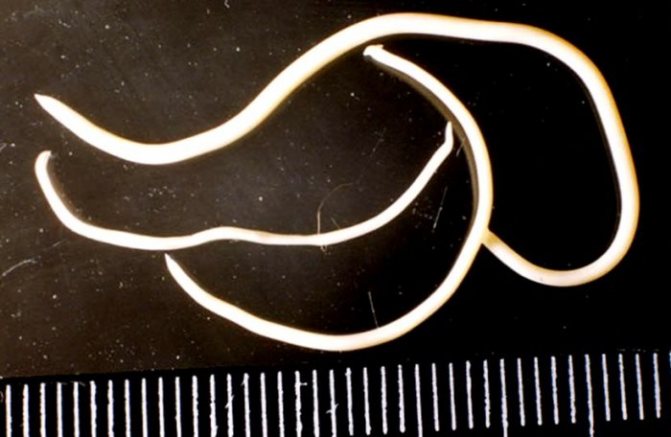

All ascariasis are quite easily treated, for which the animal is prescribed drugs based on pyrantel or praziquantel.
Heart worms
Perhaps, heartworms are the most unusual of all nematodes (and not only). Parasites of this type live directly in the cavities of the heart. For cats, this disease is rather uncharacteristic, but in disadvantaged areas it is quite common. "Scientifically" the disease is called dirofilariasis.
The life cycle of the parasite is interesting. The larvae of the worm (dirofilaria) mature in the body of mosquitoes (much less often in blood-sucking varieties of mosquitoes). They enter the insect's body when the female of the latter feeds on the blood of an already sick animal.
If the larvae of the worm, which have not yet passed "maturation" in the body of a mosquito or a mosquito, are introduced into the body of a healthy cat, infection will not occur!
The whole cycle, i.e. the time from the "sucking" of the larvae into the mouth of a bloodsucker, to the appearance of an adult worm in the cat's heart, can take several weeks or a couple of months. It all depends on the physiological state of the animal, the season, the hormonal background of the body, and other factors.
Veterinarians have long noticed that adult worms of this species (they are also pulmonary, they are also called heartworms, helminths) in the body of cats, for some reason, extremely rarely live up to a "decent" age. In addition, in the body of cats, vanishingly rarely there is more than one worm.
Symptoms and treatment
The clinical picture of the disease is no less interesting. As we wrote above, this disease is not typical for cats, and therefore there may not be a stable “clinic”. Some cats show no signs of pathology at all.
In other cases, the following may be observed:
- Cough, sometimes leading to vomiting.
- Shortness of breath, hoarse breathing.
- Chronic, progressive wasting.
The main consequences are visible not in the case when the worm is alive, but in those situations when it died!
In the body of cats, parasites of this species live for five years, sometimes up to seven. After the death of the worm, his body is destroyed. Accordingly, its pieces can tightly clog even large blood vessels. All this leads to both a sharp manifestation of the above symptoms, and the sudden death of the pet. It is with this, by the way, that the problems in treatment are associated.
The therapy is carried out by introducing into the body of the animal ... organic compounds of arsenic. Pharmacists have not yet created anything more effective. It takes two to three injections; the cat's body is hard to endure the treatment process.
For the prevention, as well as the destruction of young (very young) individuals of worms, preparations based on ivermectin are used.
Hookworm
Another interesting parasite. If you look at the English name for hookworm, i.e. Hookworms, you can guess the nature of the parasites. The fact is that this term can be translated as "worms with hooks." He quite accurately describes the appearance of these helminths. They have special hooks on their heads that serve to securely fix the parasite on the intestinal mucosa. This is precisely why Ancylostoma tubaeforme and Ancylostoma braziliense are fundamentally different from many parasitic nematodes that do not have such adaptations.
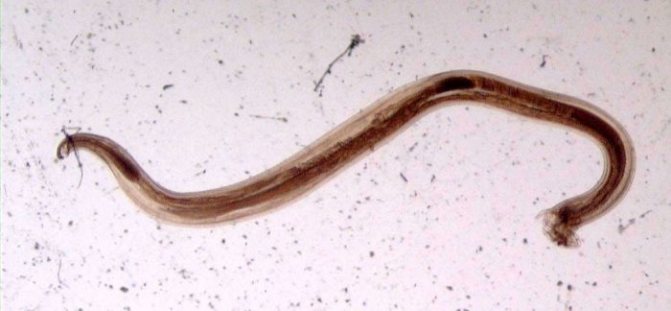

It is interesting that adult parasites, with all their "cunning" and terrible appearance, do not differ in impressive size: the length of their bodies barely reaches three millimeters.
The problem is that thousands of parasites accumulate in the intestines of a cat alone, which inevitably leads to the development of very serious consequences.
It is because of the presence of hooks that dig deeply into the intestinal wall that the disease is difficult, and its treatment is often complicated.
Infection can occur in one of three scenarios:
- "Classic", i.e. swallowing parasite eggs. Considering that female hookworms throw millions of eggs into the environment every day, as well as the "bad habits" of cats in the form of licking their paws, this method of infection can be considered the most common.
- Infection through ... skin. More precisely, through the paw pads. The skin there is thin and delicate, and therefore the "fighting" larvae with hookworms easily gnaw through it, subsequently entering the general bloodstream.
- Infection through breast milk. When the larvae enter the general bloodstream (we described this at the very beginning of the article), some of them settle in the tissues of the mammary glands. After the onset of lactation (ie milk release), they "wake up", subsequently entering the digestive tract of kittens.
Symptoms and treatment
Usually mild cases of hookworm infection occur without a clear clinical picture. The animal may be a little more lethargic, its appetite may decrease, the condition of its coat and skin may deteriorate slightly ...
But these signs will be so faded and blurred that not every veterinarian will pay attention to them, not to mention breeders.
Unfortunately, this is not always the case. If there are many of these parasites (and there are almost always a lot of them), the animal's body quickly depletes all compensatory reserves:
- Worms of this species actively feed on the mucous membranes of the intestines of the host. Over time (more precisely, very quickly), such a "buffet" leads to the development of inflammatory pathologies of the gastrointestinal tract.
- Since adults feed not only on pieces of mucous membrane, but also on blood, anemia inevitably develops in the animal.
- Accordingly, the condition of the animal is gradually deteriorating, depletion develops, in severe cases it can be fatal.
For treatment, agents based on milbemycin and praziquantel, as well as ordinary pyrantel, are excellent.
Symptoms of worms in cats
What are the signs that you can suspect the presence of worms in cats? First of all, the owner should pay attention to the following symptoms:
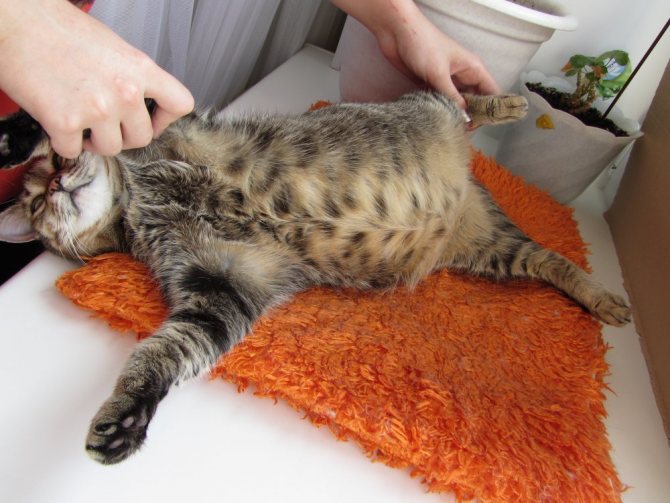

A distended belly in a cat may be a sign of a worm infection.
- a change in eating behavior - the cat begins to eat more than usual, without gaining weight, or, on the contrary, refuses even the favorite food;
- disturbances in the activity of the digestive tract - difficult defecation alternates with diarrhea, there are pieces of undigested food in the feces, which indicates a malfunction in the enzyme system;
- anemia, weakness;
- the animal often licks the anus due to itching;
- the hairline fades, the coat falls out, becomes tousled;
- mucous membranes acquire a yellow tint due to damage to the liver and gallbladder;
- the belly increases markedly in volume;
- sometimes there is a cough (a sign of the penetration of worms into the respiratory tract);
- in the feces, blood, mucus may be present.
Attention: the owner must remember that similar symptoms can occur with other diseases. Giving a cat an antihelminthic agent without laboratory confirmation of helminthiasis can worsen the condition.
Varieties of parasites
There are certain types of helminths in cats. Each of them differs in appearance, size, causing symptoms, location of the lesion, and so on. Experts, studying what worms in cats are, have identified three types of them:
- Round worms.
- Tape worms.
- Suckers.
All types of worms in cats, photos and descriptions should be considered.
Round worms
There are two subtypes of diseases with such worms in cats: ascridosis and hookworm infection. In the first case, the causative agents are white parasites, which can reach 25 cm in length. Most often, they are transmitted intrauterinely from mother to baby. But it is possible to penetrate through the mouth area along with food and drink.
Such worms multiply in the small intestine, gallbladder, pancreas.
Their larvae are able to migrate with blood to other internal organs of a cat, for example, to the lungs. From the respiratory organ, they can move into the respiratory tract, from where they again enter the intestines.
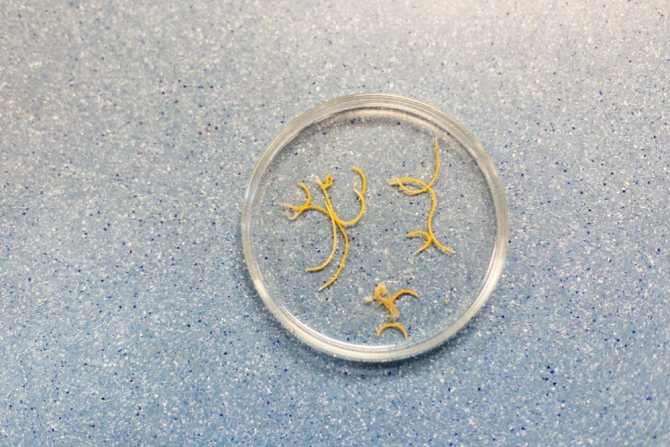

Ascaris shutterstock
As for the clinical picture with ascariasis, first of all, a person sees that the cat itches near the nose, and he begins to cough often. This is because there is a negative reaction of the body to the presence of worms.
Over time, the cat becomes weak, sleeps a lot, eats poorly, nausea, vomiting, diarrhea appears, and weight decreases.
With hookworm infection, worms parasitize, which are characterized by hooks in the oral capsule. They can pass to the animal through the mouth or skin. In the first route of infection, the worms immediately enter the intestines.
If they are introduced through the skin, then they move through the body along with the blood. They enter the lungs, from where they pass into the mouth and are swallowed, ending up in the digestive system.
Thanks to their hooks, these parasites are able to attach to the intestinal walls. They also suck in the cat's blood, while releasing components that prevent blood from clotting. Signs of helminthic invasion in this case mean weight loss, the presence of bleeding during bowel movements, and problems with stool.
Tape worms
This type of parasite in cats also occurs in two varieties:
Diphyllobothriasis. The causative agent is a broad tapeworm that settles in the small intestine. Penetration occurs when a cat eats raw fish. Because of these parasites, an inflammation process develops in the intestines, food moves poorly along the digestive tract.
This is how worms look in cats with diffilobotriosis
In the presence of this type of worms in cats, the owner may notice a deterioration in general condition, nausea, problems with stool, vomiting. The pet becomes weak, gets tired quickly, does not want to eat. It is also possible the appearance of rashes on the skin, as well as its swelling.
Dipylidiosis. With such a disease, the culprit is the "cucumber tapeworm". It also parasitizes the intestines and is white or pink in color. This worm can grow up to 70 cm in length. Infection with worms occurs through the oral cavity.
Cucumber tapeworm
Cats have the following clinical signs: weight loss, anxiety, refusal to eat, vomiting.
Suckers
Worms called flukes, or flukes, also cause two types of disease. These include:
Opisthorchiasis. Pathology arises due to the penetration of "cat fluke".Once in the body, this worm settles in the liver, bile and pancreatic ducts. Infection occurs when the animal eats raw fish.
Names and descriptions of worms with opisthorchiasis
In the presence of such parasites, a cat develops weakness, loss of body weight, lethargy. The mucous membranes become pale or yellow.
Alariosis. This disease is caused by a worm, which enters the cat's body through the mouth when it eats frogs and tadpoles. The parasite infects the intestinal mucosa, causing degenerative changes.
Alariosis
With the penetration of such worms, the pet's process of digestion of food is disrupted, and problems with emptying the intestines begin.
Diagnostics of helminthic invasions
It is not difficult to guess that a domestic cat has worms if they (or their particles) come out along with feces or vomit. Otherwise, when the above symptoms appear, as well as periodically as a preventive measure, you should contact a veterinary clinic for a diagnosis. It is better if the owner brings the animal directly to the veterinarian, because feces alone are in most cases not enough to detect parasites. This may be due to both the localization of helminths and their insufficient maturity, when the worms are not yet able to lay eggs.
Blood will be taken from the pet for laboratory research, if necessary, a sputum test will be prescribed. In some cases, your doctor may refer your cat for an x-ray of the lungs or an ultrasound of the liver and heart. In the process of identifying helminthiasis, they are differentiated from diseases of internal organs, poisoning, colds.
Symptoms of helminthiasis
The main signs of the presence of helminths in the body of a cat or cat are:
- weight loss;
- poor appetite or increased appetite in the absence of weight gain;
- digestive disorders (diarrhea, constipation, vomiting);
- anal itching;
- general depression and fatigue;
- an increase in temperature (in an advanced form or when an inflammatory process occurs);
- cough (with pulmonary form);
- an enlarged belly (more typical for small kittens);
- worms in feces;
- other signs of intoxication of the body with the waste products of worms.
It is important to understand that at the initial stage, most helminths do not make themselves felt in any way, and the presence of obvious or even mild symptoms suggests that there are a lot of parasites in the animal's body.
Symptoms and the degree of its severity largely depend on the type of parasites, their number and the state of health of the animal.
It is also worth understanding that the probability that a stray cat is infected with helminths is close to 100%, since according to data provided by veterinarians in Western Europe, 93% of tested stray animals and 25% of domestic animals had some type of helminthiasis.


Taking into account the fact that in Russia it is not very popular to clean up feces for pets, as well as a lot of stray dogs and cats, even for a completely domestic pet that does not leave the territory of the apartment, there is a possibility of infection with worms. Most often, the owners themselves, without knowing it, bring eggs of worms into the house:
- on dirty shoes;
- with raw fish or meat;
- having sheltered a homeless animal.
Treatment of worms in cats
Treatment of worms in representatives of the feline family is carried out in a comprehensive manner and consists in solving several problems:
- destroy parasites;
- ensure their rapid removal from the animal;
- detoxify the body;
- restore immunity and functional activity of damaged organs.
For this, anthelmintic drugs are used, which can be intended both for internal use and for external use. The funds are produced in different forms: tablets for worms, suspension, injections, drops.
Oral anthelmintics for cats
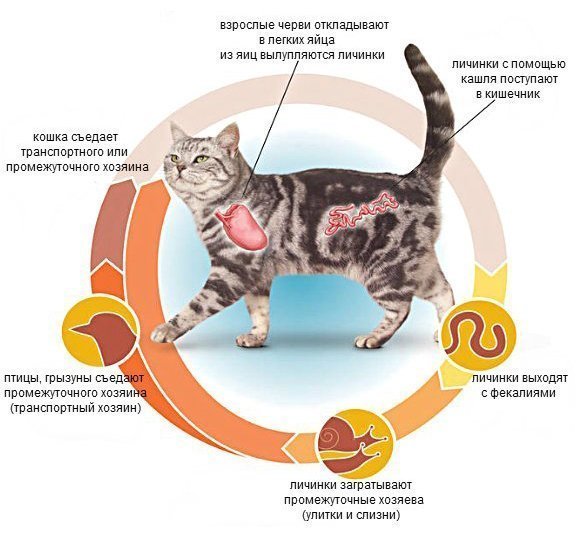

Pulmonary helminth cycle
Internal medicine for worms in cats has different effects on parasites. Some destroy the integumentary tissues and shells of eggs, others negatively affect the nervous structures, leading to paralysis of the helminth, and others disrupt metabolism. In addition, some drugs work only on adults, while others destroy larvae and eggs.
In accordance with the components that make up the drugs for worms, they are divided into drugs of a wide spectrum and aimed at exterminating only one type of worms. The latter can only be used after a well-established diagnosis.
Among the most common complex preparations for worms in cats are:
- Milbemax;
- Prazintel;
- Drontal;
- Prazicide;
- Fenasal.
While getting rid of the pet from worms, you need to carefully monitor its condition. Mass death of parasites can lead to severe intoxication of the cat, especially with a significant number of them. An animal weakened by helminths may develop vomiting and diarrhea. You can help your pet with absorbing agents: you need to give activated charcoal, enterosgel or others.
Remedies for worms for external use
External preparations for worms in cats are presented in the form of drops that are applied to the withers. These are: Bars, Profender, Drontsid and others. These tools have both pros and cons. The first include ease of use, the main thing is that the animal cannot lick the place where the drops are applied. In addition, such a medicine destroys not only internal, but also external parasites - fleas and ticks, and also serves as a prevention of their appearance.
Among the minuses, the drug's effect is not strong enough, especially with a significant number of helminths. Drops are absolutely useless to use for helminthiasis caused by trematodes, the greatest effect is achieved if the disease in a cat is provoked by nematodes.
Worm injections
In difficult cases, the veterinarian will prescribe the cat injections for worms - Ivomek or Ivermek. The procedures will need to be carried out in a clinic, since the self-preparation of the solution can lead to dosage errors and the death of the animal.
Attention: the injectable form of the drug is not a prophylactic agent.
Helminths and their types
Helminths are worms that parasitize organs and tissues (most often the intestines) of animals. The process of deworming is a set of measures aimed at eliminating worms from the body.
This process can be curative or preventive. Regular prophylaxis helps to minimize the risk of parasite infestation. Therapeutic deworming is a rather complicated procedure, since it can be difficult to identify the symptoms of the disease in a cat.


Worms in cats
Now a little about what kind of worms cats have and how they look. Among parasitic worms, there are flat or tapeworms (cestodes), flat or flukes (trematodes), and round worms (nematodes), which are sometimes called pulmonary worms because they occur in cats and in the lungs. Diseases caused by roundworms are called nematodes, tapeworms are called cestodoses, and flukes are called trematodes.
Thus, the classification of parasites that pose a danger to cats is as follows:
- Flatworms:
- cestodes (tapeworms), in particular tapeworms and tapeworms;
- trematodes (flukes), for example, opisthorchis.
- Roundworms (nematodes):
- ascaris;
- toxocara;
- hookworm.
Most often, cats are affected by tape and round worms, trematodes are much less common.
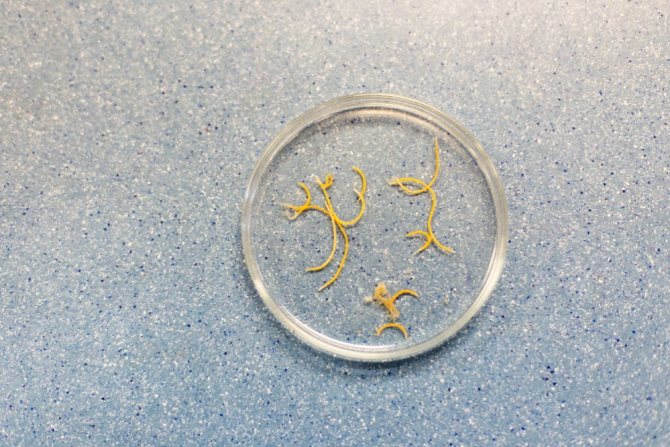

Nematodes
- Nematodes. These are small, thin worms, the spread of which occurs when their carriers come into contact with other animals, eat excrement infected with worm eggs through the milk of a sick mother. Helminths feed on blood, clinging to the walls of their host's intestines. They are especially dangerous for kittens. A person can also become infected with nematodes. Roundworms are the most common type of helminth in cats. Outwardly, these worms resemble spaghetti. Their greatest accumulation is observed in the small intestine. The massive accumulation of parasites provokes a blockage of the biliary tract and can even cause intestinal obstruction.
- Toxocars... The length is about 5 cm, they live in the gallbladder, intestines, esophagus and liver. Infection occurs by swallowing helminth eggs or through the womb (for kittens, this type of parasite poses the greatest danger, since as a result of reproduction and growth of worms, intestinal rupture can occur).
- Ascaris. Outwardly, they resemble white or slightly yellowish laces; grow up to 20 cm in length; with a strong infection, part of the adults can go outside with feces.
- Cestodes. The body length of these worms varies from 10 to 80 cm. The body of the helminth consists of a large number of segments (segments). A cat can become infected with them through contact with an intermediate host (for example, by eating a flea or rodent that were carriers of the cestode). In sick pets, you can see the segments of the cestodes, which are outwardly similar to rice grains: they are often found on the wool in the anal canal, as well as in the pet's waste products.
- Cucumber tapeworm. The pet becomes infected through fleas and lice that live on its fur. The body length of the worm is 30 cm or more. The parasite attaches itself to the intestinal walls with the help of special spines on the scolex, thereby damaging the mucous membrane of the organ.
- Wide ribbon. In length, these worms can reach 2 meters (and in the human body - 11 meters or more). Infection most often occurs through eating raw river fish.
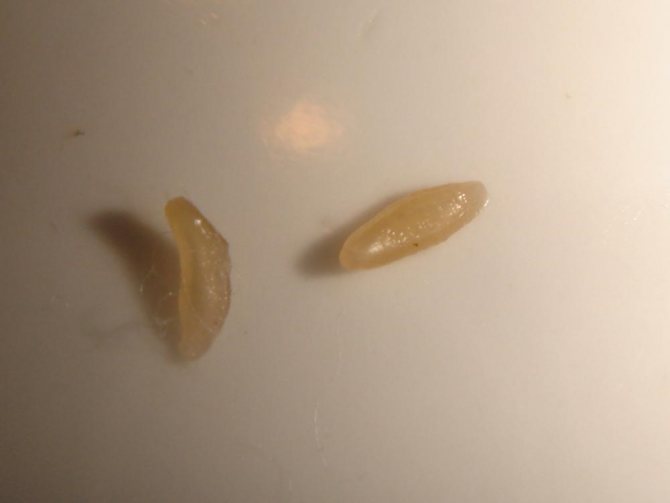

Cucumber tapeworm
Prevention of helminthiasis
To prevent the appearance of worms in cats, it is enough to adhere to the following preventive rules.
- Exclude pet contact with unfamiliar or infected animals.
- Upon arrival from the street, put your shoes in a separate closed place, preventing the cat from sniffing at it. Wipe the floor in the hallway several times a day using disinfectants.
- Regardless of whether the cat goes outside or not, treat it with external agents to keep fleas and other parasites away.
- Eliminate raw fish from the mustachioed friend's diet.
- Thoroughly and regularly wash the food tray and bowl.
Diagnostics of helminthiasis in the veterinary clinic
The veterinarian first analyzes the clinical symptoms. Cats are tested if worms are suspected. The laboratory method is the main method for diagnosing parasitic diseases - it is simple and highly reliable. Biomaterial (most often feces, less often urine, secretions, tissues, muscles) are examined for the presence of worms, their eggs and larvae. The presence of the disease is indirectly indicated by the deviation of the level of eosinophils in the general blood test.
Sometimes, to exclude systemic diseases, ultrasound and a biochemical study of blood serum are prescribed. X-rays may be needed if the lungs are affected.
To confirm the diagnosis and obtain a more complete clinical picture, in some cases, an enzyme-linked immunosorbent assay may be required, based on the presence of specific antibodies to different types of parasites in the animal's blood. It helps to accurately determine the type of pathogen, stage and intensity of the disease.
What cat worms can be transmitted to humans
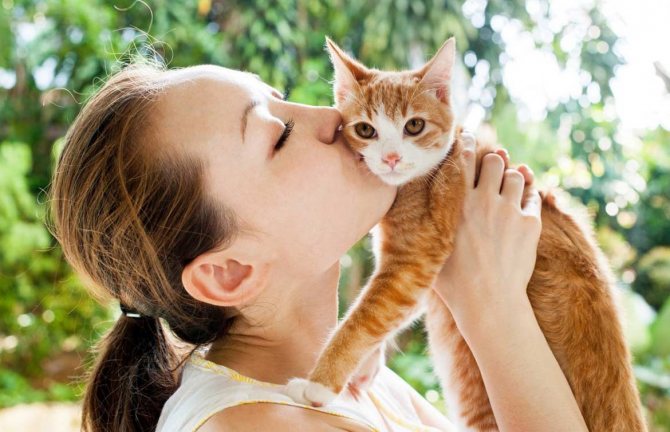

Observe preventive measures when dealing with a cat, especially if you suspect the presence of worms
Although cats can host many types of helminths, not all of them are capable of settling in humans. For example, flukes are a threat to the health of the owner: liver, pulmonary and other species. These worms "settle" in the internal organs of a person (liver, lungs), leading to disruption of their functions, tissue decay, hemorrhages, and even death.
Tape worms, such as alveococcus, cucumber tapeworm and others, can also lead to the death of the host. Anemia, allergies, blindness, death are the consequences of human infection from a cat with roundworms, nematodes.
Prevention of infection of children in families with cats is especially important. It is necessary to explain to the child why it is impossible to kiss the animal, that after contact with him, you need to wash your hands with soap, that you should not stroke stray kittens on the street, and so on.
Prevention of invasion


Drits Irina Alexandrovna. Parasitologist Helminthiasis can lead to numerous health problems, shortening life by 15-25 years. Many parasites are extremely difficult to detect. They can be anywhere - in the blood, intestines, lungs, heart, brain. Symptoms of helminthic invasion can be confused with ARVI, gastrointestinal diseases and others. The main mistake in such cases is procrastination! If you have any suspicions about the presence of parasites, then you need to contact a specialist. More information about modern methods of treating helminthiasis is described in this interview with a doctor... If we talk about medicines and self-treatment, then from the most common helminths (ascaris, pinworms, tapeworms), this antiparasitic complex.
For the prevention of helminthiasis, veterinarians recommend following the following rules:
- deworming a pet at least once every three months, especially before vaccination or mating;
- regularly treat the cat from external parasites;
- feed the animal with proven food, special food;
- observe hygiene rules and promptly clean up the trays behind the animals.
If you follow these simple rules, you will make life much easier for your pet and yourself. Remember that almost all helminths live in the human body, and not all of them can be diagnosed and 100% cured. Take care of yourself and your pet!
How to give your cat a worm medicine
Many owners are faced with the problem of how to give a pill to a cat. Pets in every possible way resist the attempts of the owners to open their mouths and push an incomprehensible bitter thing into it. To prevent physical and mental injury to both sides, a number of proven techniques can be used:
- crush the tablet into powder and pour into the mouth;
- dissolve the tablet in a small volume of water, draw it into a syringe and pour it into the cat's mouth;
- apply the pill dispenser.
Ways of infection of cats with worms
Parasites constantly circulate in the environment, larvae, eggs are in soil, water, dust, in any corner of the territory, regardless of its sanitary conditions. Signs of worms are detected in cats that never go outside, they "receive" worms in utero, or the larvae enter the house on shoes.
The risk of invasion increases with:
- the presence of raw foods (fish, meat) in the diet;
- cutaneous parasites (ticks, fleas);
- contact with infected animals;
- free range.
The cat transmits worms to the offspring in utero, therefore, before mating, it is important to give tablets for worms for cats.
How to properly rid a cat of worms
To treat a pet for helminths with the greatest efficiency, firstly, you should carefully study the instructions for the drug. It is important to strictly follow the dosage recommended by the veterinarian or annotation (in the case of self-therapy). Before starting treatment for helminthic infestation, the animal must be treated from external parasites.
Some cats manage to hold the pill in their mouth and then spit it out, so the owner must not only put the medicine in the pet's mouth, but also make sure it is swallowed.
In most cases, the medicine for worms is given to the cat two times with an interval of two weeks. This is due to the life cycle of the parasite. With an advanced disease, the doctor may prescribe a longer therapy.
After deworming, it is imperative to make sure that the activities were successful. This will require repeated, control tests.
Pet treatment
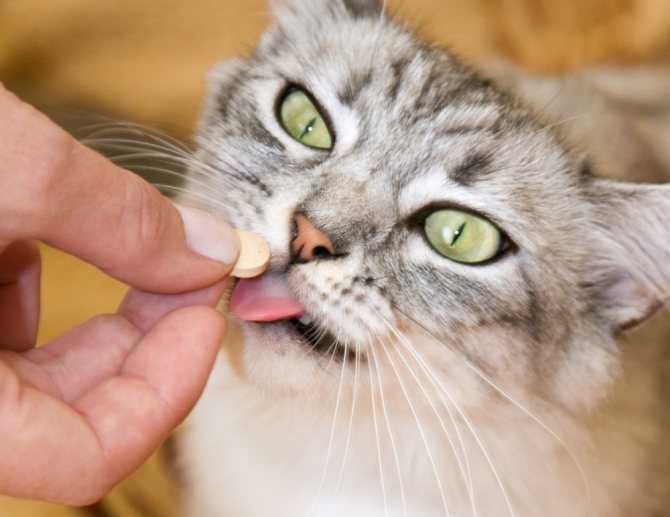

If the condition is satisfactory, the pet is treated at home. The main method of therapy is medication. There are a huge number of anthelmintic drugs on the market. They have a different spectrum of effects and application characteristics, therefore, the veterinarian prescribes the drug in each specific case, he also selects the treatment regimen and dosage. As an adjunctive therapy, you can use folk remedies, but only after consulting a doctor. A balanced, nutrient-rich diet is essential for the body to recover as quickly as possible.
Veterinary drugs prescribed by a veterinarian, an overview of the most popular
For the treatment of helminthiasis in cats, anthelmintic drugs are used. Their composition includes different active substances, they differ in the spectrum of action (for a certain type of helminths or several at once), the method of exposure to the pathogen, the form of release (tablets, suspensions, drops on the withers, pastes, solutions for injections).
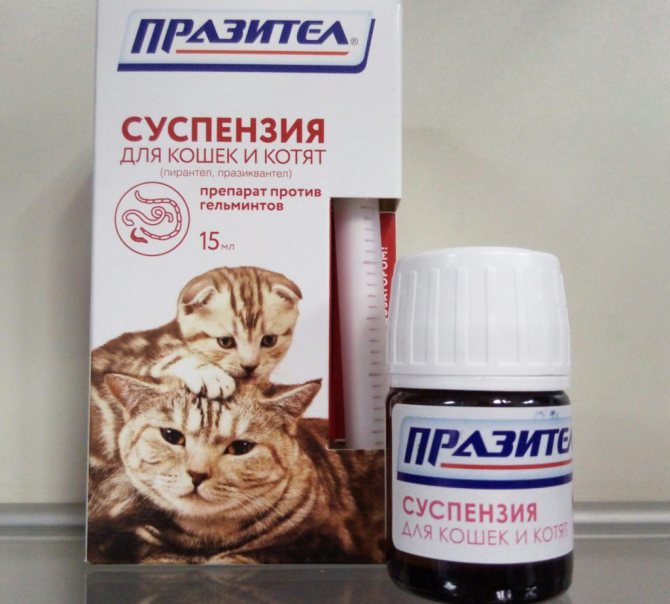

The most popular drugs used to treat parasitic infections in cats are shown in the table:
| A drug | Release form | Active substance | Impact spectrum |
| Prazitel | tablets, suspension | praziquantel, pirantela pamoat | toxocara, hookworm, echinococcus, mesocestoides lineatus, uncinaria stenocephala, whipworm, pork, cucumber tapeworm, broad tapeworm |
| Profender | drops on the withers | emodepsid, praziquantel | toxocars, hookworms, echinococcus, cucumber, pork tapeworm |
| Drontal | pills | pyrantela embonate, praziquantel | toxocara, hookworm, echinococcus, mesocestoides lineatus, cucumber, pork, bovine tapeworm |
| Milbemax | pills | milbemycin oxime, praziquantel | toxocars, hookworms, echinococcus, cucumber, pork tapeworm |
| Prazicide | tablets, suspension, drops on the withers | pyrantela pamoate, praziquantel, fenbendazole | various types of nematodes, cestodes |
Feeding and caring for a sick animal


Nutrition for helminthic invasion should be aimed at unloading the digestive tract, eliminating the symptoms of intoxication resulting from the vital activity of worms, and replenishing the lack of nutrients. Boiled chicken, turkey, rabbit, rice broth, low-fat cottage cheese, kefir, eggs are useful. It is recommended to feed the cat in small portions, the food should be at room temperature. In the absence of appetite, you can offer chicken broth, baby canned meat. The cat must consume enough water.
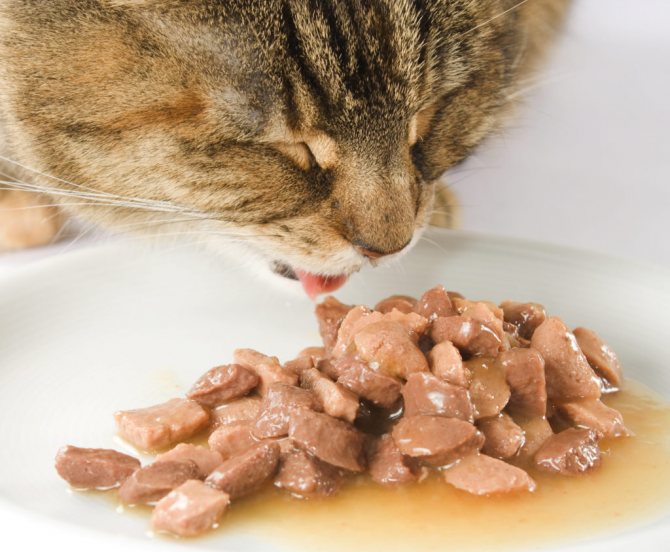

It is not recommended to feed the animal with cheap, low-quality food - they contain a lot of cereals that are not nutritional value for cats, and they do not provide the body with the necessary substances, vitamins and microelements. To unload the gastrointestinal tract when eating ready-made feed, you can replace dry feed with wet feed of the same brand.
On the day of taking some drugs, in order to achieve a high level of the active substance in the habitat of the parasites, the cat is shown fasting.
With helminthiasis, the pet often feels weak and lies a lot. You need to provide him with maximum comfort and not disturb. Keep the tray clean. With helminthic invasion, discharge from the eyes sometimes appears, they must be wiped with cotton pads dipped in chamomile decoction or a special lotion.
Folk remedies for worms
Traditional medicine offers several ways with which you can save a cat from worms:


- Pumpkin seeds. 5 g of seeds are crushed together with the peel, add the same amount of pork fat or vegetable oil. The remedy is given on an empty stomach for 5 days. The mixture is effective against flatworms.
- Onion infusion. Cut the onion into 4 parts, pour a glass of warm water. It is consumed in the morning on an empty stomach for a week.
- Garlic. The pet is fed 1 clove for 7 days. Allergic reactions are possible!


Water infusion of tansy. Dried flowers are poured with a glass of hot water, insisted for about an hour, filtered and given to the pet 2.5 ml three times a day for 7 days. After taking the drug, you should not feed the animal for an hour.
It should be noted that the effectiveness of folk remedies in the treatment of helminthiasis in cats has not been proven, in addition, many of them can be dangerous to the pet, for example celandine (the plant is poisonous) or alcohol tincture of wormwood. Losing time on dubious treatment threatens to aggravate the disease, it will be more difficult to get rid of worms.
When deworming should not be carried out
There are several situations when you need to wait a little while treating cats for worms:
- serious condition of the pet;
- exacerbation of infectious diseases;
- pregnancy of a cat;
- lactation period;
- newborn kittens (usually, age restrictions are indicated in the annotation to the drug).
It can be difficult to deworm an aging cat. At this age, an animal should be treated for worms only in consultation with a specialist.
Deworming an animal
Deworming - a set of actions aimed at the destruction and subsequent evacuation of parasites with the restoration of organs, cleansing of cavities and tissues and the subsequent prevention of re-infection. In order to accurately diagnose the disease and prescribe treatment, it is necessary to show the animal to the veterinarian at the first symptoms so that he can determine the type of worms and prescribe a therapy that is suitable for your pet.
There are broad-spectrum drugs that can help with any type of worms:
- Parasicide - suitable for adult animals, but dangerous for small kittens;
- Profender - a product in the form of drops, suitable for both adults and kittens older than one month;
- Drontal - in the form of tablets, can be used from three weeks and older.
Table: drugs depending on the type of helminthic invasion
| Group of drugs | Name of the medication | Mode of application |
| A drug for the treatment of trematodes | Hexychol | It is given once at the rate of 0.2 g per 1 kg of the cat's weight. For intake, mix with feed. |
| Droncite | Mixed with feed and applied once. Ratio: 5 mg per 11 kg of body weight. | |
| Hexychol C | It is mixed with feed and taken once. Ratio: 0.15 g of the drug per 1 kg of the animal. | |
| Veterinary remedies for nematodes | Nilverm | A 1% aqueous solution is used. Ratio: 0.02 g per 1 kg of weight. It is taken twice a day. For kittens, the proportion is 0.01 g per kilogram of weight. |
| Naphtamon | Added to feed, applied once. Ratio: 0.2 g / kg. Before the procedure, it is necessary to provide the animal with a 15-hour fast. | |
| Ivomek | It is used as an injection. Proportions: 0.5 ml per 5 kg. | |
| Medicines for the treatment of cestodes | Fenalidon | Added to food, single use. Proportions: 100 mg per kilogram of body weight. |
| Fenasal | It is added to food, taken once. Ratio: 0.15 g per 1 kg of weight. | |
| Lopatol | Single dose of 50 mg per 1 kg of animal weight | |
| Bunamidin | Single dose of 50 mg per 1 kg of animal weight |
Worms: clinical signs
Does the cat have worms? The severity of symptoms depends on the type of helminth, its location, size, the number of parasitic individuals, the age of the animal and its state of health.
Common symptoms of helminthic invasion include:
- depression, appetite perversion, or anorexia;
- bad coat, strong shedding;
- dry crusts in the corners of the eyes without inflammation;
- disruption of the digestive tract (constipation, diarrhea, vomiting);
- intestinal obstruction;
- a swollen, barrel-shaped belly;
- anemia, a sharp decrease in immunity;
There may be blood in the feces, kittens are stunted, and intoxication may cause convulsions. In feces or vomit, whole sexually mature worms are found, sometimes segments, often fragments of a cucumber tapeworm come out of the anus and "hang on the wool."


Where are the helminths?
Symptoms of worms in cats depend on the location. In the body of an animal, parasites can be found in any tissue, organ or circulatory system.
- Specific localization.
Certain species of parasites live in well-defined areas. The diagnosis with a specific localization is easier than with the "disorderly" movement of worms in the body. Habitat: gastrointestinal tract, liver, biliary tract, heart, lungs, blood vessels, kidneys, ureter, eyes.
- Perverted (non-specific).
The parasite is located in an unusual localization, causing atypical symptoms of the disease, which complicates the diagnosis. Most often, perverted localization is observed in liver flukes, roundworms (toxocara, roundworm).
- Transit.
Eggs and larvae of helminths pass through the body without affecting it and not staying for a long time. They are accidentally found in the study of feces, a complete examination of the animal. There are no clinical symptoms of the presence of worms inside the cat.

